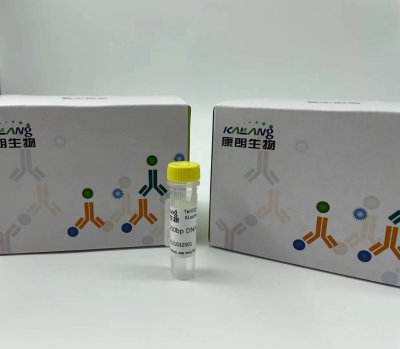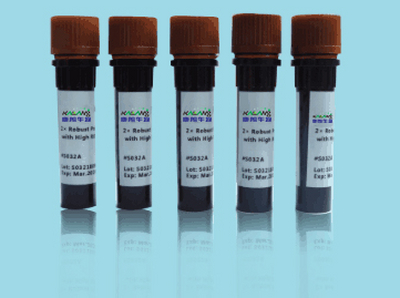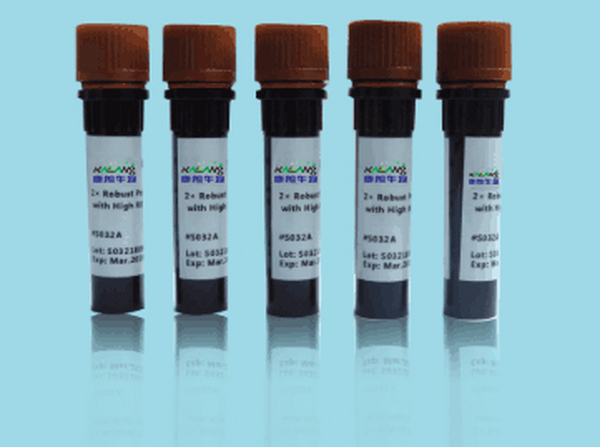QQ:3002763590


客服电话:021-61998208
CysLTR1 rabbit Polyclonal Antibody
CysLTR1抗体
CysLTR1抗体应用:Western Blot: 1/500 - 1/2000. Immunofluorescence: 1/200 - 1/1000. ELISA: 1/5000. cysteinyl leukotriene receptor 1(CYSLTR1) Homo sapiens This gene encodes a member of the G-protein coupled receptor 1 family. The encoded protein is a receptor for cysteinyl leukotrienes, and is involved in mediating bronchoconstriction via activation of a phosphatidylinositol-calcium second messenger system. Activation of the encoded receptor results in contraction and proliferation of bronchial smooth muscle cells, eosinophil migration, and damage to the mucus layer in the lung. Upregulation of this gene is associated with asthma and dysregulation may also be implicated in cancer. Alternative splicing results in multiple transcript variants. [provided by RefSeq, Aug 2013],
CysLTR1 rabbit Polyclonal Antibody
CysLTR1抗体
CysLTR1抗体应用:Western Blot: 1/500 - 1/2000. Immunohistochemistry: 1/100 - 1/300. Immunofluorescence: 1/200 - 1/1000. ELISA: 1/10000. cysteinyl leukotriene receptor 1(CYSLTR1) Homo sapiens This gene encodes a member of the G-protein coupled receptor 1 family. The encoded protein is a receptor for cysteinyl leukotrienes, and is involved in mediating bronchoconstriction via activation of a phosphatidylinositol-calcium second messenger system. Activation of the encoded receptor results in contraction and proliferation of bronchial smooth muscle cells, eosinophil migration, and damage to the mucus layer in the lung. Upregulation of this gene is associated with asthma and dysregulation may also be implicated in cancer. Alternative splicing results in multiple transcript variants. [provided by RefSeq, Aug 2013],
CysLTR2 rabbit Polyclonal Antibody
CysLTR2抗体
CysLTR2抗体应用:Western Blot: 1/500 - 1/2000. Immunofluorescence: 1/200 - 1/1000. ELISA: 1/40000. cysteinyl leukotriene receptor 2(CYSLTR2) Homo sapiens The cysteinyl leukotrienes LTC4, LTD4, and LTE4 are important mediators of human bronchial asthma. Pharmacologic studies have determined that cysteinyl leukotrienes activate at least 2 receptors, the protein encoded by this gene and CYSLTR1. This encoded receptor is a member of the superfamily of G protein-coupled receptors. It seems to play a major role in endocrine and cardiovascular systems. [provided by RefSeq, Jul 2008],
CysLTR2 rabbit Polyclonal Antibody
CysLTR2抗体
CysLTR2抗体应用:Western Blot: 1/500 - 1/2000. Immunofluorescence: 1/200 - 1/1000. ELISA: 1/20000. cysteinyl leukotriene receptor 2(CYSLTR2) Homo sapiens The cysteinyl leukotrienes LTC4, LTD4, and LTE4 are important mediators of human bronchial asthma. Pharmacologic studies have determined that cysteinyl leukotrienes activate at least 2 receptors, the protein encoded by this gene and CYSLTR1. This encoded receptor is a member of the superfamily of G protein-coupled receptors. It seems to play a major role in endocrine and cardiovascular systems. [provided by RefSeq, Jul 2008],
Cystatin 11 rabbit Polyclonal Antibody
Cystatin 11抗体
Cystatin 11抗体应用:Western Blot: 1/500 - 1/2000. ELISA: 1/40000.cystatin 11(CST11) Homo sapiens The cystatin superfamily encompasses proteins that contain multiple cystatin-like sequences. Some of the members are active cysteine protease inhibitors, while others have lost or perhaps never acquired this inhibitory activity. There are three inhibitory families in the superfamily, including the type 1 cystatins (stefins), type 2 cystatins and the kininogens. The type 2 cystatin proteins are a class of cysteine proteinase inhibitors found in a variety of human fluids and secretions. The cystatin locus on chromosome 20 contains the majority of the type 2 cystatin genes and pseudogenes. This gene is located in the cystatin locus and encodes an epididymal-specific protein shown to have antimicrobial activity against E. coli. Alternative splicing yields two variants encoding distinct isoforms. [provided by RefSeq, Sep 2014],
Cystatin 8 rabbit Polyclonal Antibody
Cystatin 8抗体
Cystatin 8抗体应用:Immunohistochemistry: 1/100 - 1/300. ELISA: 1/40000.cystatin 8(CST8) Homo sapiens The cystatin superfamily encompasses proteins that contain multiple cystatin-like sequences. Some of the members are active cysteine protease inhibitors, while others have lost or perhaps never acquired this inhibitory activity. There are three inhibitory families in the superfamily, including the type 1 cystatins (stefins), type 2 cystatins and the kininogens. The type 2 cystatin proteins are a class of cysteine proteinase inhibitors found in a variety of human fluids and secretions. The cystatin locus on chromosome 20 contains the majority of the type 2 cystatin genes and pseudogenes. This gene is located in the cystatin locus and encodes a protein similar to type 2 cystatins. The encoded protein exhibits highly tissue-specific expression in the reproductive tract, suggesting implicit roles in reproduction. Alternative splicing results in multiple transcript variants. [provided by RefSeq,
Cystatin A rabbit Polyclonal Antibody
Cystatin A抗体
Cystatin A抗体应用:WB 1:500-2000,IHC-p 1:500-200, ELISA 1:10000-20000 cystatin A(CSTA) Homo sapiens The cystatin superfamily encompasses proteins that contain multiple cystatin-like sequences. Some of the members are active cysteine protease inhibitors, while others have lost or perhaps never acquired this inhibitory activity. There are three inhibitory families in the superfamily, including the type 1 cystatins (stefins), type 2 cystatins, and kininogens. This gene encodes a stefin that functions as a cysteine protease inhibitor, forming tight complexes with papain and the cathepsins B, H, and L. The protein is one of the precursor proteins of cornified cell envelope in keratinocytes and plays a role in epidermal development and maintenance. Stefins have been proposed as prognostic and diagnostic tools for cancer. [provided by RefSeq, Jul 2008],
Cystatin A rabbit Polyclonal Antibody
Cystatin A抗体
Cystatin A抗体应用:Western Blot: 1/500 - 1/2000. Immunohistochemistry: 1/100 - 1/300. Immunofluorescence: 1/200 - 1/1000. ELISA: 1/5000. cystatin A(CSTA) Homo sapiens The cystatin superfamily encompasses proteins that contain multiple cystatin-like sequences. Some of the members are active cysteine protease inhibitors, while others have lost or perhaps never acquired this inhibitory activity. There are three inhibitory families in the superfamily, including the type 1 cystatins (stefins), type 2 cystatins, and kininogens. This gene encodes a stefin that functions as a cysteine protease inhibitor, forming tight complexes with papain and the cathepsins B, H, and L. The protein is one of the precursor proteins of cornified cell envelope in keratinocytes and plays a role in epidermal development and maintenance. Stefins have been proposed as prognostic and diagnostic tools for cancer. [provided by RefSeq, Jul 2008],
Cystatin B rabbit Polyclonal Antibody
Cystatin B抗体
Cystatin B抗体应用:IHC-p 1:50-200, ELISA 1:10000-20000 cystatin B(CSTB) Homo sapiens The cystatin superfamily encompasses proteins that contain multiple cystatin-like sequences. Some of the members are active cysteine protease inhibitors, while others have lost or perhaps never acquired this inhibitory activity. There are three inhibitory families in the superfamily, including the type 1 cystatins (stefins), type 2 cystatins and kininogens. This gene encodes a stefin that functions as an intracellular thiol protease inhibitor. The protein is able to form a dimer stabilized by noncovalent forces, inhibiting papain and cathepsins l, h and b. The protein is thought to play a role in protecting against the proteases leaking from lysosomes. Evidence indicates that mutations in this gene are responsible for the primary defects in patients with progressive myoclonic epilepsy (EPM1). One type of mutation responsible for EPM1 is the expansion in the promoter region of this gene of a CCCCGCCCCGCG re
Cystatin B rabbit Polyclonal Antibody
Cystatin B抗体
Cystatin B抗体应用:Western Blot: 1/500 - 1/2000. Immunohistochemistry: 1/100 - 1/300. Immunofluorescence: 1/200 - 1/1000. ELISA: 1/20000.cystatin B(CSTB) Homo sapiens The cystatin superfamily encompasses proteins that contain multiple cystatin-like sequences. Some of the members are active cysteine protease inhibitors, while others have lost or perhaps never acquired this inhibitory activity. There are three inhibitory families in the superfamily, including the type 1 cystatins (stefins), type 2 cystatins and kininogens. This gene encodes a stefin that functions as an intracellular thiol protease inhibitor. The protein is able to form a dimer stabilized by noncovalent forces, inhibiting papain and cathepsins l, h and b. The protein is thought to play a role in protecting against the proteases leaking from lysosomes. Evidence indicates that mutations in this gene are responsible for the primary defects in patients with progressive myoclonic epilepsy (EPM1). One type of mutation responsible
最新动态
-

Anti-GNGT1 KL20092-001(50ul)
2021-10-11 -

Anti-GNGT1 antibody(50ul) KL20093-001
2021-10-11 -

α-tubulin mouse Monoclonal Antibody
2021-01-08 -

α-tubulin mouse Monoclonal Antibody(8F11)
2021-01-08
热门标签
- Histone H3 rabbit Polyclonal Antibody Histone H3抗体
- EGFR rabbit Polyclonal Antibody EGFR抗体
- Cy3 Conjugated
- AbFluor™ 555 Conjugated
- AbFluor™ 680 Conjugated
- AbFluor™ 350 Conjugated
- AbFluor™ 647 Conjugated
- AbFluor™ 594 Conjugated
- AbFluor™ 405 Conjugated
- Cy5 Conjugated
- AbFluor™ 488 Conjugated
- Cyclophilin B抗体 Cyclophilin B Monoclonal Antibody(2B10)
- COX IV抗体 COX IV Monoclonal Antibody(6C8)
- PCNA抗体 PCNA Monoclonal Antibody(12D10)
- FAK rabbit Polyclonal Antibody FAK抗体
邮箱:3002763590@qq.com
电话:021-61998208

扫码关注微信公众号






